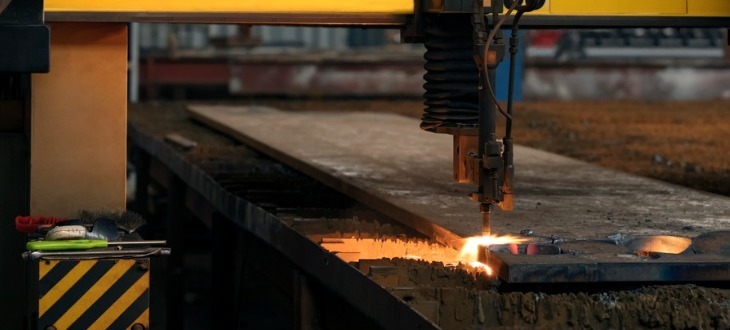Whether it’s aluminum, steel, or stainless steel, customers purchasing metal require some level of processing from the larger stock. From sizing to holes to more elaborate designs or ornamentation, there is an almost limitless combination of needs. Each project can require a different processing approach or specialized equipment, which is why such a wide range of approaches exists.
For cutting metals, shaping metals, or creating holes or designs, two of the most widely used tools are plasma cutters and torch cutters. While both involve the application of heat to get the job done, there are key differences between the two. Neither approach is better than the other, but there are advantages and disadvantages depending on the job.
The following overview of a plasma cutter versus a torch cutter will give you a clear understanding of how both processes work, as well as the advantages and disadvantages of each. Tampa Steel & Supply offers a full array of metal processing services and we’re happy to work with our customers to achieve the best result for any need.
What is Plasma Cutting?
Plasma cutting, also called plasma arc cutting, uses jets of very high temperature ionized gasses to heat metal to a melting point where it can be cleanly cut from a larger piece. This process requires a compressed gas that is focused through a nozzle at a very high speed, creating an electrical arc. While the high temperature of the electrical arc melts the metal being worked on, the velocity and compression of the gas work to cleanly blow the metal away, creating separation.
Plasma cutting was originally developed to cut electrically conductive alloys that could not be cut as effectively by the oxy-fuel torch cutting process. Today, it is most often used on steel, stainless steel, and aluminum.
Pros and Cons of Plasma Cutting
The major advantages and disadvantages of plasma cutting can be job specific, and also dependent on the specific equipment being used.
Typically, the pros of plasma cutting include the following:
- Quick starts: Plasma cutters have the advantage of warming metal up quickly compared to torch cutting, which generally requires a preheating period to get the metal to ignition temperature.
- Fast cutting speeds: Particularly on thinner metals, plasma offers the ability to cut through the metal at a faster rate due to the concentrated, high heat involved.
- Clean cuts: Plasma cutters can create cleaner cuts without the edges and chipping that can result from metal on metal cutting applications.
- Less warpage: Another advantage is that plasma creates a narrower cone of heat, which means that it doesn’t heat the surrounding metal and limits the warping that can occur.
- Diverse shapes: Because of the accuracy, plasma torches can create curves, holes, and other shapes more easily than other processes, particularly with the advancement of computer assisted cutting technology.
Some of the cons of plasma cutting are that plasma torches do not work on as wide a range of metals, and the cutting speed advantage can diminish on thicker lengths. Additionally, plasma cutters require an electrical source, so they are often not as portable as a torch cutter.
What is Torch Cutting?
Most commonly known as oxy-fuel torch cutting, this approach is the traditional method for torch cutting metal, and has been around for more than a hundred years. An oxy-fuel cutting torch mixes oxygen with a fuel gas, such as acetylene, to create the heat necessary to raise the temperature of the metal to its kindling point. Oxygen is then used to create a stream that helps to flow the melted metal away from the intended cut.
Pros and Cons of Torch Cutting
As with plasma cutting, the pros and cons of oxy-fuel torch cutting can be dependent on the type of job, the metal, and the equipment being used. Advantages of torch cutting include:
- Faster for thicker metals: Once the thickness of the metal being cut increases, oxy-fuel torches can create quicker cuts, although they may not be as clean.
- Versatile: Oxy-fuel torches can be used on non-conductive metals because they don’t use an electrical arc to create heat.
- More portable: Oxy-fuel torches do not require an independent power supply and are fully self-contained, so they may be the best tool for certain remote cutting jobs.
Many of the cons for oxy-fuel torch cutters line up with the advantages of plasma cutting. Torch cutting requires a long warm up time for the metal to reach kindling temperature, and it can often be more difficult to create clean lines without warping compared to plasma torches.
The important thing to understand is that the right type of cutting method very often depends on a number of factors, including budget, type of metal, timeframe, and the type of cut required. No matter what your need is, the experts at Tampa Steel & Supply can guide you to the right type of metal and cutting method for you.
Visit Tampa Steel & Supply for Quality Metal and Metal Processing Services
Are you in need of steel supplies and processing? Look no further than the professionals at Tampa Steel and Supply. We stock an extensive list of steel products for whatever project you need to tackle. We’re proud to have served our customers for nearly four decades and are ready to assist you with your steel needs. Have questions? Give us a call today to learn more, or stop by our beautiful Tampa showroom.
We believe our customers are the strength of our business. This is why we pride ourselves on delivering not only quality products and services, but compassionate customer service too. We’re here to help you every step of the way and can assist you with any service you may need!
Request a Quote Online
Or Call Tampa Steel & Supply at (813) 241-2801

